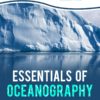Physical oceanography is the study of physical conditions and physical processes within the ocean, especially the motions and physical properties of ocean waters. Physical oceanography is one of several sub-domains into which oceanography is divided. Others include biological, chemical and geological oceanography’s. The scientific discipline of Physical Oceanography involves the exploration and study of physical processes in the ocean, the interaction of the ocean with the atmosphere, and the ocean’s role in the Earth’s climate and ecosystems. Some of the major themes of physical oceanography are the dynamics of ocean currents on spatial scales ranging from centimeters to global, the variability of these currents on time-scales from seconds to millennia, ocean wave phenomena, the distribution of heat and salt and other water properties and their transport by currents through the ocean basins, the exchange of momentum, heat, freshwater and gasses between the ocean and the atmosphere, and the interactions between oceans and rivers, estuaries, sea-ice, terrestrial-ice and marginal seas. Physical oceanography has important applications in global climate studies and coastal systems, as well as being a key element in interdisciplinary studies of primary production, hydrothermal vents, and the exchange and storage of carbon dioxide. The book “Data Analysis Methods in Physical Oceanography” deals with established and modern data analysis techniques in earth and ocean sciences.








